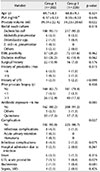1. Loeb S, Carter HB, Berndt SI, Ricker W, Schaeffer EM. Complications after prostate biopsy: data from SEER-Medicare. J Urol. 2011; 186:1830–1834.

2. Tufan ZK, Bulut C, Yazan T, Hatipoglu C, Erdinc S, Kinikli S, et al. A life-threatening Escherichia coli meningitis after prostate biopsy. Urol J. 2011; 8:69–71.
3. Wolf JS Jr, Bennett CJ, Dmochowski RR, Hollenbeck BK, Pearle MS, Schaeffer AJ. Urologic Surgery Antimicrobial Prophylaxis Best Practice Policy Panel. Best practice policy statement on urologic surgery antimicrobial prophylaxis. J Urol. 2008; 179:1379–1390.

4. Cek M, Tandogdu Z, Naber K, Tenke P, Wagenlehner F, van Oostrum E, et al. Antibiotic prophylaxis in urology departments, 2005-2010. Eur Urol. 2013; 63:386–394.

5. Feliciano J, Teper E, Ferrandino M, Macchia RJ, Blank W, Grunberger I, et al. The incidence of fluoroquinolone resistant infections after prostate biopsy--are fluoroquinolones still effective prophylaxis? J Urol. 2008; 179:952–955.

6. Horcajada JP, Busto M, Grau S, Sorli L, Terradas R, Salvado M, et al. High prevalence of extended-spectrum beta-lactamase-producing enterobacteriaceae in bacteremia after transrectal ultrasound-guided prostate biopsy: a need for changing preventive protocol. Urology. 2009; 74:1195–1199.

7. Chung HS, Hwang EC, Yu HS, Jung SI, Lee SJ, Lim DH, et al. Prevalence of fluoroquinolone-resistant rectal flora in patients undergoing transrectal ultrasound-guided prostate needle biopsy: a prospective multicenter study. Int J Urol. 2018; 25:278–283.

8. Ozden E, Bostanci Y, Yakupoglu KY, Akdeniz E, Yilmaz AF, Tulek N, et al. Incidence of acute prostatitis caused by extended-spectrum beta-lactamase-producing Escherichia coli after transrectal prostate biopsy. Urology. 2009; 74:119–123.

9. Batura D, Rao GG, Bo Nielsen P, Charlett A. Adding amikacin to fluoroquinolone-based antimicrobial prophylaxis reduces prostate biopsy infection rates. BJU Int. 2011; 107:760–764.

10. Kehinde EO, Al-Maghrebi M, Sheikh M, Anim JT. Combined ciprofloxacin and amikacin prophylaxis in the prevention of septicemia after transrectal ultrasound guided biopsy of the prostate. J Urol. 2013; 189:911–915.

11. Adibi M, Hornberger B, Bhat D, Raj G, Roehrborn CG, Lotan Y. Reduction in hospital admission rates due to post-prostate biopsy infections after augmenting standard antibiotic prophylaxis. J Urol. 2013; 189:535–540.

12. Adibi M, Pearle MS, Lotan Y. Cost-effectiveness of standard vs intensive antibiotic regimens for transrectal ultrasonography (TRUS)-guided prostate biopsy prophylaxis. BJU Int. 2012; 110:E86–E91.

13. Zani EL, Clark OA, Rodrigues Netto N Jr. Antibiotic prophylaxis for transrectal prostate biopsy. Cochrane Database Syst Rev. 2011; (5):CD006576.

14. Marino K, Parlee A, Orlando R, Lerner L, Strymish J, Gupta K. Comparative effectiveness of single versus combination antibiotic prophylaxis for infections after transrectal prostate biopsy. Antimicrob Agents Chemother. 2015; 59:7273–7275.

15. Batura D, Rao GG, Nielsen PB. Prevalence of antimicrobial resistance in intestinal flora of patients undergoing prostatic biopsy: implications for prophylaxis and treatment of infections after biopsy. BJU Int. 2010; 106:1017–1020.

16. Nam RK, Saskin R, Lee Y, Liu Y, Law C, Klotz LH, et al. Increasing hospital admission rates for urological complications after transrectal ultrasound guided prostate biopsy. J Urol. 2010; 183:963–968.

17. Taylor AK, Zembower TR, Nadler RB, Scheetz MH, Cashy JP, Bowen D, et al. Targeted antimicrobial prophylaxis using rectal swab cultures in men undergoing transrectal ultrasound guided prostate biopsy is associated with reduced incidence of postoperative infectious complications and cost of care. J Urol. 2012; 187:1275–1279.

18. Duplessis CA, Bavaro M, Simons MP, Marguet C, Santomauro M, Auge B, et al. Rectal cultures before transrectal ultrasound-guided prostate biopsy reduce post-prostatic biopsy infection rates. Urology. 2012; 79:556–561.

19. Tsu JH, Ma WK, Chan WK, Lam BH, To KC, To WK, et al. Prevalence and predictive factors of harboring fluoroquinolone-resistant and extended-spectrum β-lactamase-producing rectal flora in Hong Kong Chinese men undergoing transrectal ultrasound-guided prostate biopsy. Urology. 2015; 85:15–21.

20. Unnikrishnan R, El-Shafei A, Klein EA, Jones JS, Kartha G, Goldman HB. For single dosing, levofloxacin is superior to ciprofloxacin when combined with an aminoglycoside in preventing severe infections after prostate biopsy. Urology. 2015; 85:1241–1246.

21. Miyazaki Y, Akamatsu S, Kanamaru S, Kamiyama Y, Sengiku A, Iguchi R, et al. A prospective randomized trial comparing a combined regimen of amikacin and levofloxacin to levofloxacin alone as prophylaxis in transrectal prostate needle biopsy. Urol J. 2016; 13:2533–2540.
22. Gopal Rao G, Batura D. Emergency hospital admissions attributable to infective complications of prostate biopsy despite appropriate prophylaxis: need for additional infection prevention strategies? Int Urol Nephrol. 2014; 46:309–315.

23. Son KC, Chung HS, Jung SI, Kim MS, Hwang EC, Kim JW, et al. Trial comparing a combined regimen of amikacin and ciprofloxacin to ciprofloxacin alone as transrectal prostate biopsy prophylaxis in the era of high fluoroquinolone-resistant rectal flora. J Korean Med Sci. 2018; 33:e113.

24. Kanafani ZA, Mehio-Sibai A, Araj GF, Kanaan M, Kanj SS. Epidemiology and risk factors for extended-spectrum beta-lactamase-producing organisms: a case control study at a tertiary care center in Lebanon. Am J Infect Control. 2005; 33:326–332.

25. Lautenbach E, Patel JB, Bilker WB, Edelstein PH, Fishman NO. Extended-spectrum beta-lactamase-producing Escherichia coli and Klebsiella pneumoniae: risk factors for infection and impact of resistance on outcomes. Clin Infect Dis. 2001; 32:1162–1171.

26. Hyle EP, Lipworth AD, Zaoutis TE, Nachamkin I, Bilker WB, Lautenbach E. Impact of inadequate initial antimicrobial therapy on mortality in infections due to extended-spectrum beta-lactamase-producing enterobacteriaceae: variability by site of infection. Arch Intern Med. 2005; 165:1375–1380.

27. Hwang EC, Jung SI, Seo YH, Jeong SH, Kwon DD, Park K, et al. Risk factors for and prophylactic effect of povidone-iodine rectal cleansing on infectious complications after prostate biopsy: a retrospective cohort study. Int Urol Nephrol. 2015; 47:595–601.

28. Ryu JW, Jung SI, Ahn JH, Hwang EC, Yu HS, Kang TW, et al. Povidone-iodine rectal cleansing and targeted antimicrobial prophylaxis using rectal swab cultures in men undergoing transrectal ultrasound-guided prostate biopsy are associated with reduced incidence of postoperative infectious complications. Int Urol Nephrol. 2016; 48:1763–1770.







 PDF
PDF ePub
ePub Citation
Citation Print
Print




 XML Download
XML Download